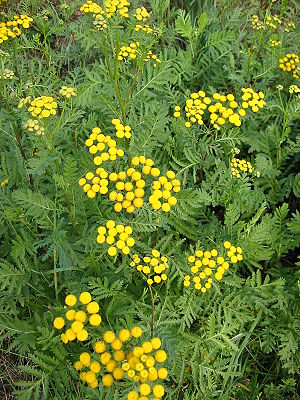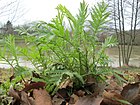Note: This is a project under development. The articles on this wiki are just being initiated and broadly incomplete. You can Help creating new pages.
Tanacetum vulgare - Tansy
Bitter buttons is a perennial, herbaceous flowering plant of the aster family, native to temperate Europe and Asia. It has been introduced to other parts of the world including North America, and in some areas has become invasive.
Contents
- 1 Uses
- 2 Parts Used
- 3 Chemical Composition
- 4 Common names
- 5 Properties
- 6 Habit
- 7 Identification
- 8 List of Ayurvedic medicine in which the herb is used
- 9 Where to get the saplings
- 10 Mode of Propagation
- 11 How to plant/cultivate
- 12 Commonly seen growing in areas
- 13 Photo Gallery
- 14 References
- 15 External Links
Uses
Intestinal ulcers, Gas problems, Bloating, Stomachache, Skin eruptions, Poor appetite, Migraines, Nerve pain, Joint pain, Epileptic seizures, Fever.
Parts Used
Chemical Composition
The applicable parts of tansy are the above ground parts. Tansy contains beta-sitosterol as the major sterol and alpha-amyrin as the major triterpene. Tansy also contains sterols stigmasterol, campesterol and cholesterol, and the triterpenes beta-amyrin and taraxasterol. The successful therapeutic application of this herb may be due partly to the presence of one or more of these compounds; however, results are inconclusive[1]
Common names
| Language | Common name |
|---|---|
| Kannada | |
| Hindi | Dhoop, Guggul |
| Malayalam | |
| Tamil | |
| Telugu | |
| Marathi | NA |
| Gujarathi | NA |
| Punjabi | NA |
| Kashmiri | NA |
| Sanskrit | |
| English | Long-Leaved Tansy |
Properties
Reference: Dravya - Substance, Rasa - Taste, Guna - Qualities, Veerya - Potency, Vipaka - Post-digesion effect, Karma - Pharmacological activity, Prabhava - Therepeutics.
Dravya
Rasa
Tikta (Bitter), Kashaya (Astringent)
Guna
Laghu (Light), Ruksha (Dry), Tikshna (Sharp)
Veerya
Ushna (Hot)
Vipaka
Katu (Pungent)
Karma
Kapha, Vata
Prabhava
Habit
Identification
Leaf
| Kind | Shape | Feature |
|---|---|---|
| Simple | Alternate | Stalkless–short-stalked. Blade usually pinnately lobed, sparsely haired, dotted with glands, lobes lanceolate, with tapered tips |
Flower
| Type | Size | Color and composition | Stamen | More information |
|---|---|---|---|---|
| Unisexual | 7–11 mm | Yellow | 5-20 | Single flower-like, usually capitula, surrounded by involucral bracts. Capitula’s ray-florets lacking and Flowering time is July–September |
Fruit
| Type | Size | Mass | Appearance | Seeds | More information |
|---|---|---|---|---|---|
| 7–10 mm (0.28–0.4 in.) long pome | Many-ridged achene, tip with shallow | inland often around inhabited areas | many | {{{6}}} |
Other features
List of Ayurvedic medicine in which the herb is used
- Vishatinduka Taila as root juice extract
Where to get the saplings
Mode of Propagation
How to plant/cultivate
Landscape Uses:Container. Succeeds in an ordinary garden soil[1]. Plants thrive in almost any soil[4]. Tansy is occasionally grown in the herb garden, though a site for growing this plant should be selected with care since it usually spreads very aggressively at the roots[[3]
Commonly seen growing in areas
Photo Gallery
References
External Links
- Ayurvedic Herbs known to be helpful to treat Intestinal ulcers
- Ayurvedic Herbs known to be helpful to treat Gas problems
- Ayurvedic Herbs known to be helpful to treat Bloating
- Ayurvedic Herbs known to be helpful to treat Stomachache
- Ayurvedic Herbs known to be helpful to treat Skin eruptions
- Ayurvedic Herbs known to be helpful to treat Poor appetite
- Ayurvedic Herbs known to be helpful to treat Migraines
- Ayurvedic Herbs known to be helpful to treat Nerve pain
- Ayurvedic Herbs known to be helpful to treat Joint pain
- Ayurvedic Herbs known to be helpful to treat Epileptic seizures
- Ayurvedic Herbs known to be helpful to treat Fever
- Herbs with Flowers used in medicine
- Herbs with Leaves used in medicine
- Herbs with common name in Hindi
- Herbs with common name in English
- Habit - Perennial plant
- Index of Plants which can be propagated by Seeds
- Index of Plants which can be propagated by Cuttings
- Herbs that are commonly seen in the region of Waste ground
- Herbs that are commonly seen in the region of Hedgerows
- Herbs
- Ayurvedic herbs that don't have seed photos
- Asteraceae




